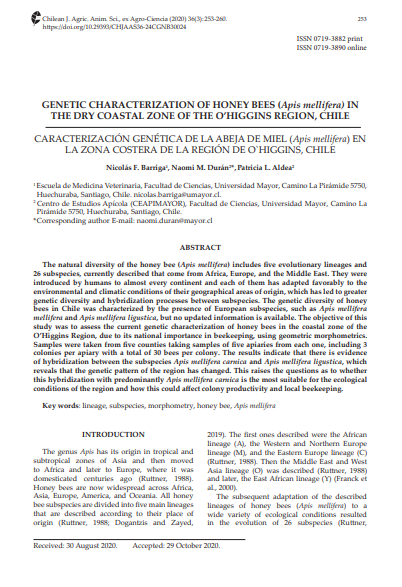GENETIC CHARACTERIZATION OF HONEY BEES (Apis mellifera) IN THE DRY COASTAL ZONE OF THE O'HIGGINS REGION, CHILE

Fecha
2021-01Autor
Barriga, Nicolas F.
Durán, Naomi M. [Univ Mayor, Ctr Estudios Apicola CEAPIMAYOR, Fac Ciencias, Chile]
Aldea, Patricia L. [Univ Mayor, Ctr Estudios Apicola CEAPIMAYOR, Fac Ciencias, Chile]
Ubicación geográfica
Notas
HERRAMIENTAS
Acceda a títulos restringidos
¿Cómo descargar?Resumen
The natural diversity of the honey bee (Apis mellifera) includes five evolutionary lineages and 26 subspecies, currently described that come from Africa, Europe, and the Middle East. They were introduced by humans to almost every continent and each of them has adapted favorably to the environmental and climatic conditions of their geographical areas of origin, which has led to greater genetic diversity and hybridization processes between subspecies. The genetic diversity of honey bees in Chile was characterized by the presence of European subspecies, such as Apis mellifera mellifera and Apis mellifera ligustica, but no updated information is available. The objective of this study was to assess the current genetic characterization of honey bees in the coastal zone of the O'Higgins Region, due to its national importance in beekeeping, using geometric morphometrics. Samples were taken from five counties taking samples of five apiaries from each one, including 3 colonies per apiary with a total of 30 bees per colony. The results indicate that there is evidence of hybridization between the subspecies Apis mellifera carnica and Apis mellifera ligustica, which reveals that the genetic pattern of the region has changed. This raises the questions as to whether this hybridization with predominantly Apis mellifera carnica is the most suitable for the ecological conditions of the region and how this could affect colony productivity and local beekeeping.
URI
https://repositorio.umayor.cl/xmlui/handle/sibum/9323https://www.scielo.cl/pdf/chjaasc/v36n3/0719-3890-chjaasc-chjaas36-24cgnb30024.pdf
http://dx.doi.org/10.29393/chjaas36-24cgnb30024
Coleccion/es a la/s que pertenece:
Si usted es autor(a) de este documento y NO desea que su publicación tenga acceso público en este repositorio, por favor complete el formulario aquí.